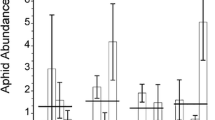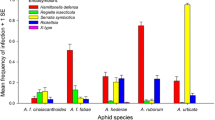Abstract
Phytophagous insects generally feed on a restricted range of host plants, using a number of different sensory and behavioural mechanisms to locate and recognize their host plants. Phloem-feeding aphids have been shown to exhibit genetic variation for host preference of different plant species and genetic variation within a plant species can also have an effect on aphid preference and acceptance. It is known that genotypic interactions between barley genotypes and Sitobion avenae aphid genotypes influence aphid fitness, but it is unknown if these different aphid genotypes exhibit active host choice (preference) for the different barley genotypes. Active host choice by aphid genotypes for particular plant genotypes would lead to assortative association (non-random association) between the different aphid and plant genotypes. The performance of each aphid genotype on the plant genotypes also has the ability to enhance these interactions, especially if the aphid genotypes choose the plant genotype that also infers the greatest fitness. In this study, we demonstrate that different aphid genotypes exhibit differential preference and performance for different barley genotypes. Three out of four aphid genotypes exhibited preference for (or against) particular barley genotypes that were not concordant with differences in their reproductive rate on the specific barley genotype. This suggests active host choice of aphids is the primary mechanism for the observed pattern of non-random associations between aphid and barley genotypes. In a community context, such genetic associations between the aphids and barley can lead to population-level changes within the aphid species. These interactions may also have evolutionary effects on the surrounding interacting community, especially in ecosystems of limited species and genetic diversity.


Similar content being viewed by others
References
Agrawal AA, Underwood N, Stinchcombe JR (2004) Intraspecific variation in the strength of density dependence in aphid populations. Ecol Entomol 29:521–526
Alvarez AE, Tjallingli WF, Garzo E, Vleeshouwers V, Dicke M, Vosman B (2006) Location of resistance factors in the leaves of potato and wild tuber-bearing Solanum species to the aphid Myzus persicae. Entomol Exp Appl 121:145–157
Astles PA, Moore AJ, Preziosi RF (2005) Genetic variation in response to an indirect ecological effect. Proc R Soc B Biol Sci 272:2577–2581
Bailey JK, Schweitzer JA, Rehill BJ, Lindroth RL, Martinsen GD, Whitham TG (2004) Beavers as molecular geneticists: a genetic basis to the foraging of an ecosystem engineer. Ecology 85:603–608
Barbour RC, Forster LG, Baker SC, Steane DA, Potts BM (2009) Biodiversity consequences of genetic variation in bark characteristics within a foundation tree species. Conserv Biol 5:1146–1155
Broekgaarden C, Poelman EH, Voorrips RE, Dicke M, Vosman B (2010) Intraspecific variation in herbivore community composition and transcriptional profiles in field-grown Brassica oleracea cultivars. J Exp Bot 61:807–819
Bukovinszky T, van Veen FJ, Jongema Y, Dicke M (2008) Direct and indirect effects of resource quality on food web structure. Science 319:804–807
Caillaud MC, Via SV (2000) Specialized feeding behavior influences both ecological specialization and assortative mating in sympatric host races of pea aphids. Am Nat 156:606–621
Carius HJ, Little TJ, Ebert D (2001) Genetic variation in a host-parasite association: potential for coevolution and frequency-dependent selection. Evolution 55:1136–1145
Chapman RF (2003) Contact chemoreception in feeding by phytophagous insects. Annu Rev Entomol 48:455–484
De Barro PJ, Sherratt TN, David O, Maclean N (1995) An investigation of the differential performance of clones of the aphid Sitobion avenae on two host species. Oecologia 104:379–385
Dungey HS, Potts BM, Whitham TG, Li HF (2000) Plant genetics affects arthropod community richness and composition: evidence from a synthetic eucalypt hybrid population. Evolution 54:1938–1946
Emelianov I, Simpson F, Narang P, Mallet J (2003) Host choice promotes reproductive isolation between host races of the larch budmoth Zeiraphera diniana. J Evol Biol 16:208–218
Ferrari J, Godfray HC, Faulconbridge AS, Prior K, Via S (2006) Population differentiation and genetic variation in host choice among pea aphids from eight host plant genera. Evolution 60:1574–1584
Floate KD, Fernandes GW, Nilsson JA (1996) Distinguishing intrapopulational categories of plants by their insect faunas: galls on rabbitbrush. Oecologia 105:221–229
Fritschi FB, Rosa J, Lin H, Johnson MW, Groves RL (2007) Behavioral responses of Homalodisca vitripennis (Hemiptera: Auchenorrhyncha : Cicadellidae) on four Vitis genotypes. Environ Entomol 36:926–937
Fritz RS, Price PW (1988) Genetic variation among plants and insect community structure: willows and sawflies. Ecology 69:845–856
Gaylord ES, Preszler RW, Boecklen WJ (1996) Interactions between host plants, endophytic fungi, and a phytophagous insect in an oak (Quercus grisea x Q. gambelii) hybrid zone. Oecologia 105:336–342
Gorur G, Lomonaco C, Mackenzie A (2007) Phenotypic plasticity in host choice behavior in black bean aphid, Aphis fabae (Homoptera: Aphididae). Arthropod Plant Interact 1:187–194
Gripenberg S, Morriën E, Cudmore A, Salminen JP, Roslin T (2007) Resource selection by female moths in a heterogeneous environment: what is a poor girl to do? J Anim Ecol 76:854–865
Hochwender CG, Fritz RS (2004) Plant genetic differences influence herbivore community structure: evidence from a hybrid willow system. Oecologia 138:547–557
Iason GR, Lennon JJ, Pakeman RJ, Thoss V, Beaton JK, Sim DA, Elston DA (2005) Does chemical composition of individual Scots pine trees determine the biodiversity of their associated ground vegetation? Ecol Lett 8:364–369
Johnson MTJ, Lajeunesse MJ, Agrawal AA (2006) Additive and interactive effects of plant genotypic diversity on arthropod communities and plant fitness. Ecol Lett 9:24–34
Kant MR, Sabelis MW, Haring MA, Schuurink RC (2008) Intraspecific variation in a generalist herbivore accounts for differential induction and impact of host plant defences. Proc R Soc B Biol Sci 275:443–452
Karban R, Agrawal AA (2002) Herbivore offense. Annu Rev Ecol Syst 33:641–664
Lewisohn TM, Novotny V, Basset Y (2005) Insects on plants: diversity of herbivore assemblages revisited. Ann Rev Ecol Evol Syst 36:597–620
McCauley GW Jr, Margolies DC, Reese JC (1990) Feeding behavior, fecundity and weight of sorghum- and corn-reared greenbugs on corn. Entomol Exp Appl 55:183–190
Muller MS, McWilliams SR, Podlesak D, Donaldson JR, Bothwell HM, Lindroth RL (2006) Tri-trophic effects of plant defenses: chickadees consume caterpillars based on host leaf chemistry. Oikos 114:507–517
Nikolakakis NN, Margaritopoulos JT, Tsitsipis JA (2003) Performance of Myzus persicae (Hemiptera: Aphididae) clones on different host-plants and their host preference. Bull Entomol Res 93:235–242
Powell G, Tosh CR, Hardie J (2006) Host plant selection by aphids: behavioral, evolutionary, and applied perspectives. Annu Rev Entomol 51:309–330
Ranger CM, Singh AP, Johnson-Cicalese J, Polavarapu S, Vorsa N (2007) Intraspecific variation in aphid resistance and constitutive phenolics exhibited by the wild blueberry Vaccinium darrowi. J Chem Ecol 33:711–729
Rovenska GZ, Zemek R (2006) Host plant preference of aphids, thrips and spider mites on GNA-expressing and control potatoes. Phytoparasitica 34:139–148
Service P (1984) Genotypic interactions in an aphid-host plant relationship: uroleucon rudbeckiae and Rudbeckia laciniata. Oecologia 61:271–276
Sokal RR, Rohlf JF (2000) Biometry: the principles and practice of statistics in biological research, 3rd edn. W.H. Freeman and Company, New York
Stiling P, Rossi AM (1996) Complex effects of genotype and environment on insect herbivores and their enemies. Ecology 77:2212–2218
Stireman JO, Nason JD, Heard SB, Seehawer JM (2006) Cascading host-associated genetic differentiation in parasitoids of phytophagous insects. Proc R Soc B Biol Sci 273:523–530
Tétard-Jones C, Kertesz MA, Gallois P, Preziosi RF (2007) Genotype-by-genotype interactions modified by a third species in a plant-insect system. Am Nat 170:492–499
Thompson JN (1988) Evolutionary ecology of the relationship between oviposition preference and performance of offspring in phytophagous insects. Entomol Exp Appl 47:3–14
Thompson JN, Burdon JJ (1992) Gene-for-gene coevolution between plants and parasites. Nature 360:121–125
Via S (1991) Specialized host plant performance of pea aphid clones is not altered by experience. Ecology 72:1420–1427
Vickerman GP, Wratten SD (1979) The biology and pest status of cereal aphids (Hemiptera: Aphididae) in Europe: a review. Bull Entomol Res 69:1–32
Whitham TG, Young WP, Martinsen GD, Gehring CA, Schweitzer JA, Shuster SM, Wimp GM, Fischer DG, Bailey JK et al (2003) Community and ecosystem genetics: a consequence of the extended phenotype. Ecology 84:559–573
Zytynska SE, Fleming S, Tetard-Jones C, Kertesz MA, Preziosi RF (2010) Community genetic interactions mediate indirect ecological effects between a parasitoid wasp and rhizobacteria. Ecology 91:1563–1568
Zytynska SE, Fay MF, Penny D, Preziosi RF (2011) Genetic variation in a tropical tree species influences the associated epiphytic plant and invertebrate communities in a complex forest ecosystem. Phil Trans R Soc B 366:1329–1336.
Acknowledgments
We thank P. Lunt and L. Andrejczak for assistance with data collection, P. Hayes for barley seed and Rothamsted Research, UK for the aphid genotypes. This work was funded by a NERC PhD studentship to S.E.Z.
Author information
Authors and Affiliations
Corresponding author
Rights and permissions
About this article
Cite this article
Zytynska, S.E., Preziosi, R.F. Genetic interactions influence host preference and performance in a plant-insect system. Evol Ecol 25, 1321–1333 (2011). https://doi.org/10.1007/s10682-011-9493-7
Received:
Accepted:
Published:
Issue Date:
DOI: https://doi.org/10.1007/s10682-011-9493-7




